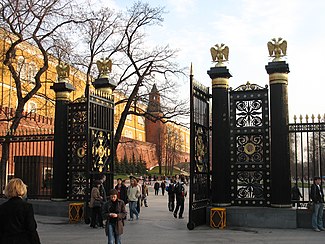Alexander Garden
This article needs additional citations for verification. (February 2022) |
You can help expand this article with text translated from the corresponding article in Russian. (January 2023) Click [show] for important translation instructions.
|
| Alexander Garden Александровский сад | |
|---|---|
 | |
 | |
| Type | Urban park |
| Coordinates | 55°45′09″N 37°36′50″E / 55.75250°N 37.61389°E |
| Created | 1823 |
| Status | Open all year |
| Public transit access | Metro: |
Alexander Gardens (
History

Until the 18th century, the Neglinnaya River flowed on the site of Alexandrovsky Gardens, over which four bridges were built. Historically, folk festivals were held on the river banks, its water was clean and famous for fishing.[1] After the end of the Napoleonic Wars, Emperor Alexander I decided to take the river underground and enclose it in a pipe three kilometres long. Gardens were laid out in the vacated place, designed by the architect Osip Bove as part of a plan to restore Moscow after the fire of 1812.[2]
The gardens were built from 1819 to 1823 and were originally called the Kremlin Gardens. After the coronation of Alexander II in 1856, the gardens were renamed the Alexander Gardens.
Layout
Upper Garden
Towards the main entrance to the park is the
In front of the grotto is an
The wrought iron grille, enclosing this part of the garden, has a design of fasces, which are intended to commemorate the military victory over Napoleon.
The northern part of the garden is adjacent to the large underground shopping complex at Manege Square.
Middle Garden
The most prominent feature of the Middle Garden is the outlying
Lower Garden
Laid out in 1823, the Lower Garden stretches to the road leading to the Borovitskaya Tower, one of two vehicular and pedestrian entrances to the Kremlin.
References
- ^ "Знаменитые исторические Здания — Узнай Москву". um.mos.ru. Retrieved 2021-10-11.
- ^ "Александровский сад — Москва. Энциклопедический справочник". Gufo.me (in Russian). Retrieved 2021-10-11.
External links
 Media related to Alexandrovsky Garden, Moscow at Wikimedia Commons
Media related to Alexandrovsky Garden, Moscow at Wikimedia Commons
